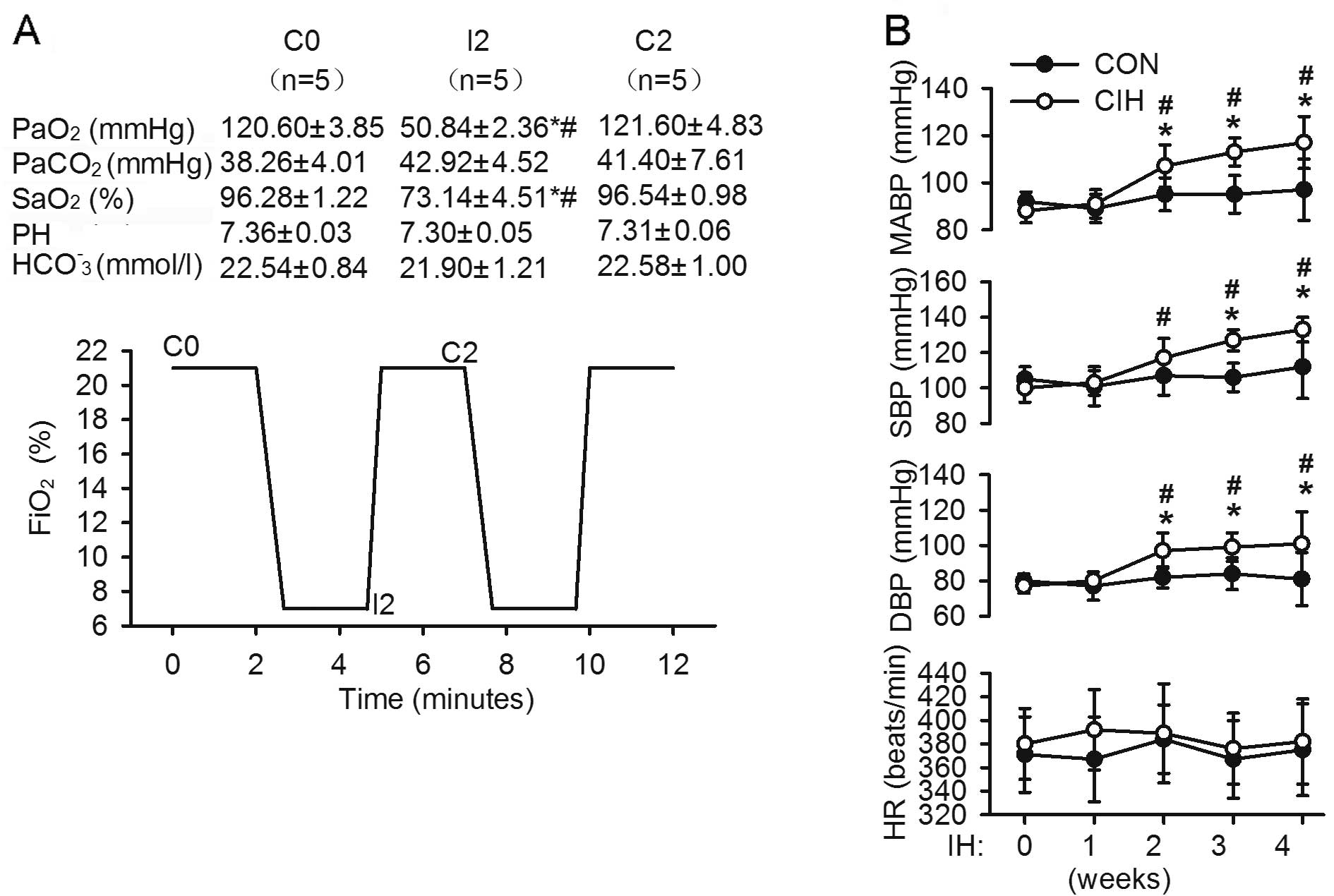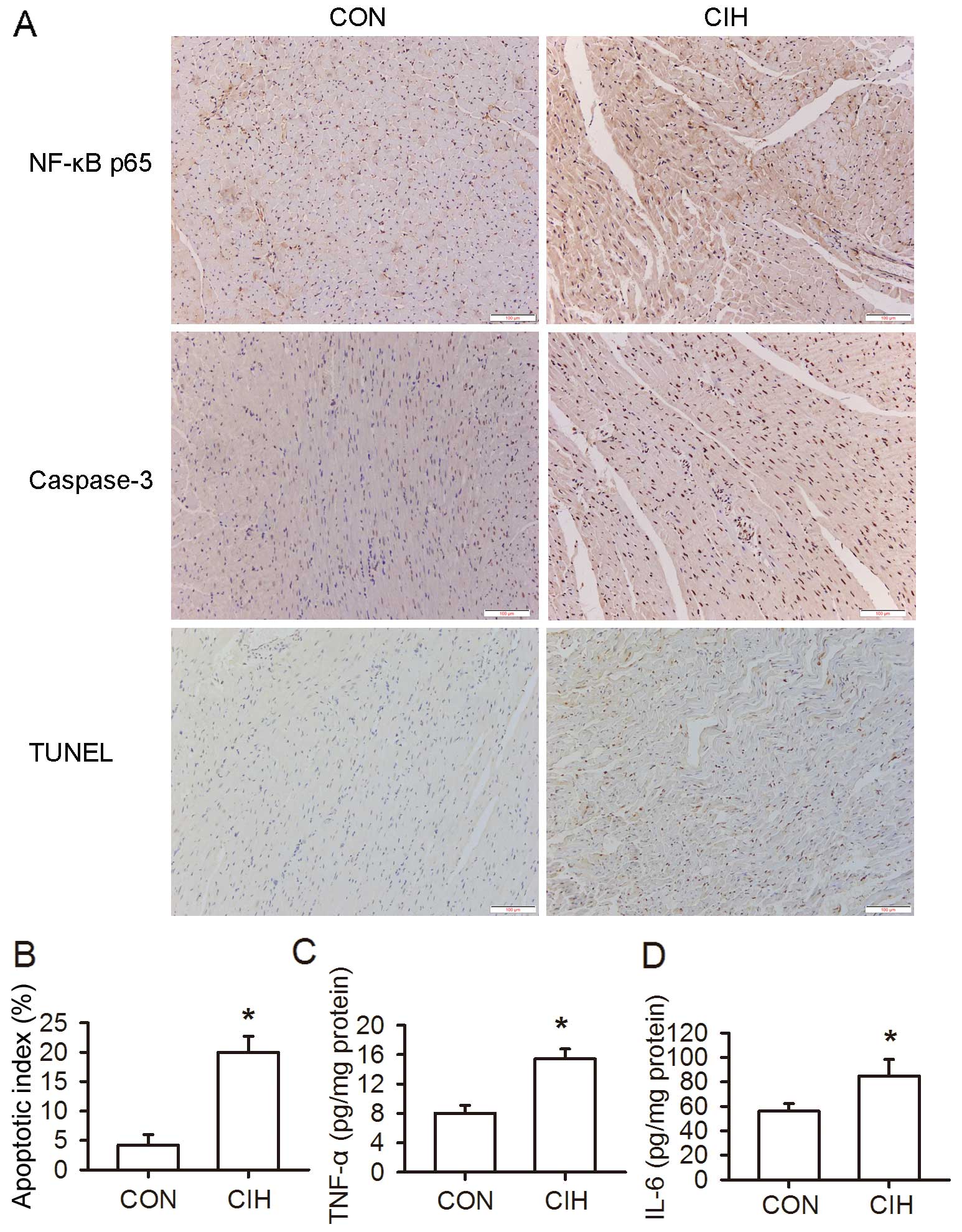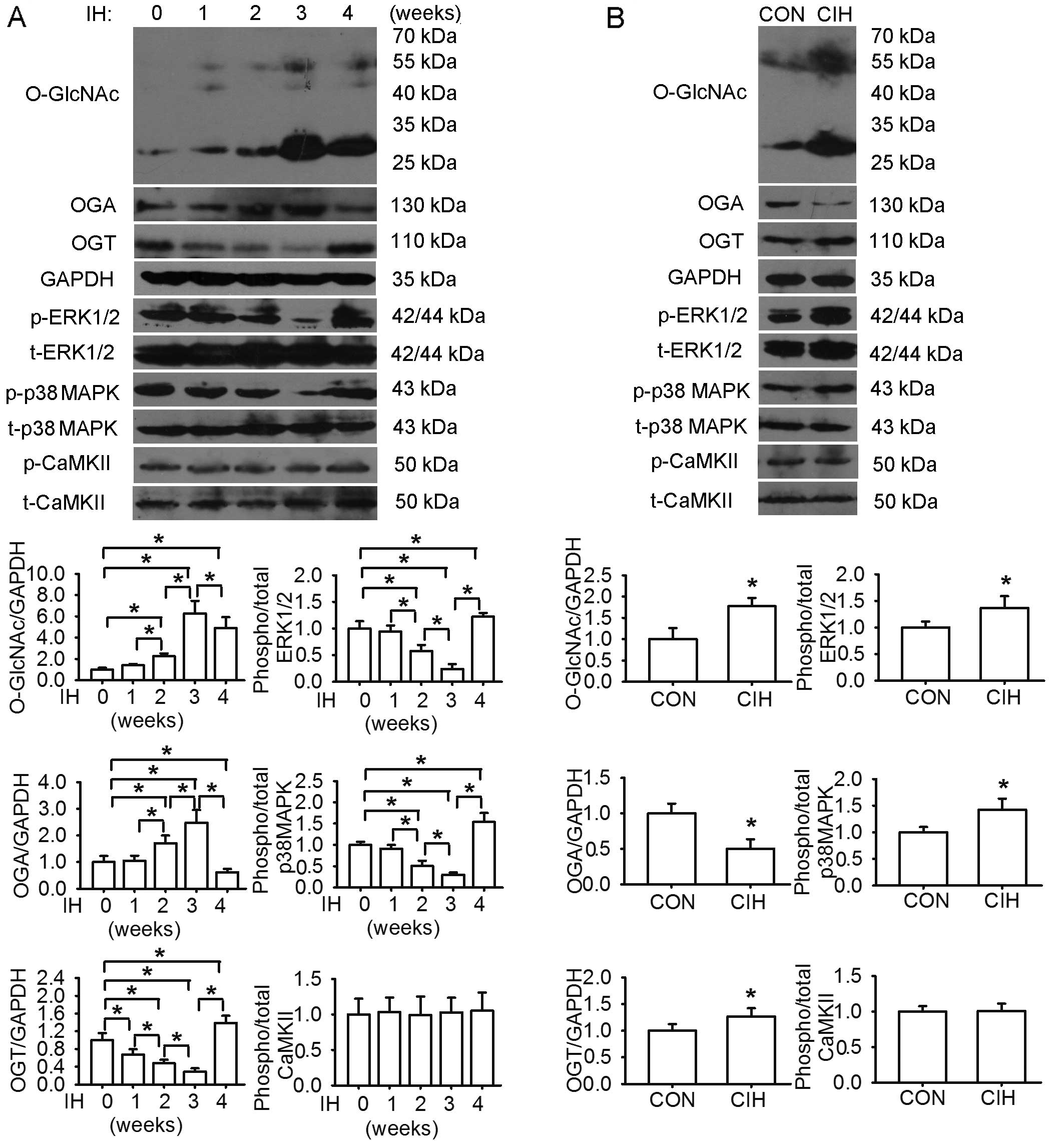|
1
|
Lima VV, Spitler K, Choi H, Webb RC and
Tostes RC: O-GlcNAcylation and oxidation of proteins: Is signalling
in the cardiovascular system becoming sweeter? Clin Sci (Lond).
123:473–486. 2012. View Article : Google Scholar
|
|
2
|
Dassanayaka S and Jones SP: O-GlcNAc and
the cardiovascular system. Pharmacol Ther. 142:62–71. 2014.
View Article : Google Scholar :
|
|
3
|
Hart GW, Housley MP and Slawson C: Cycling
of O-linked beta-N-acetylglucosamine on nucleocytoplasmic proteins.
Nature. 446:1017–1022. 2007. View Article : Google Scholar : PubMed/NCBI
|
|
4
|
Hart GW, Slawson C, Ramirez-Correa G and
Lagerlof O: Cross talk between O-GlcNAcylation and phosphorylation:
Roles in signaling, transcription, and chronic disease. Annu Rev
Biochem. 80:825–858. 2011. View Article : Google Scholar : PubMed/NCBI
|
|
5
|
Wang Z, Gucek M and Hart GW: Cross-talk
between GlcNAcylation and phosphorylation: Site-specific
phosphorylation dynamics in response to globally elevated O-GlcNAc.
Proc Natl Acad Sci USA. 105:13793–13798. 2008. View Article : Google Scholar : PubMed/NCBI
|
|
6
|
Vaidyanathan K, Durning S and Wells L:
Functional O-GlcNAc modifications: Implications in molecular
regulation and pathophysiology. Crit Rev Biochem Mol Biol.
49:140–163. 2014. View Article : Google Scholar : PubMed/NCBI
|
|
7
|
Groves JA, Lee A, Yildirir G and Zachara
NE: Dynamic O-GlcNAcylation and its roles in the cellular stress
response and homeostasis. Cell Stress Chaperones. 18:535–558. 2013.
View Article : Google Scholar : PubMed/NCBI
|
|
8
|
Vibjerg Jensen R, Johnsen J, Buus
Kristiansen S, Zachara NE and Bøtker HE: Ischemic preconditioning
increases myocardial O-GlcNAc glycosylation. Scand Cardiovasc J.
47:168–174. 2013. View Article : Google Scholar : PubMed/NCBI
|
|
9
|
Facundo HT, Brainard RE, Watson LJ, Ngoh
GA, Hamid T, Prabhu SD and Jones SP: O-GlcNAc signaling is
essential for NFAT-mediated transcriptional reprogramming during
cardiomyocyte hypertrophy. Am J Physiol Heart Circ Physiol.
302:H2122–H2130. 2012. View Article : Google Scholar : PubMed/NCBI
|
|
10
|
Hilgers RH, Xing D, Gong K, Chen YF,
Chatham JC and Oparil S: Acute O-GlcNAcylation prevents
inflammation-induced vascular dysfunction. Am J Physiol Heart Circ
Physiol. 303:H513–H522. 2012. View Article : Google Scholar : PubMed/NCBI
|
|
11
|
Ngoh GA, Watson LJ, Facundo HT and Jones
SP: Augmented O-GlcNAc signaling attenuates oxidative stress and
calcium overload in cardiomyocytes. Amino Acids. 40:895–911. 2011.
View Article : Google Scholar :
|
|
12
|
Wu T, Zhou H, Jin Z, Bi S, Yang X, Yi D
and Liu W: Cardio-protection of salidroside from
ischemia/reperfusion injury by increasing N-acetylglucosamine
linkage to cellular proteins. Eur J Pharmacol. 613:93–99. 2009.
View Article : Google Scholar : PubMed/NCBI
|
|
13
|
Zou L, Yang S, Champattanachai V, Hu S,
Chaudry IH, Marchase RB and Chatham JC: Glucosamine improves
cardiac function following trauma-hemorrhage by increased protein
O-GlcNAcylation and attenuation of NF-{kappa}B signaling. Am J
Physiol Heart Circ Physiol. 296:H515–H523. 2009. View Article : Google Scholar
|
|
14
|
Yang S, Zou LY, Bounelis P, Chaudry I,
Chatham JC and Marchase RB: Glucosamine administration during
resuscitation improves organ function after trauma hemorrhage.
Shock. 25:600–607. 2006. View Article : Google Scholar : PubMed/NCBI
|
|
15
|
Fava C, Montagnana M, Favaloro EJ, Guidi
GC and Lippi G: Obstructive sleep apnea syndrome and cardiovascular
diseases. Semin Thromb Hemost. 37:280–297. 2011. View Article : Google Scholar : PubMed/NCBI
|
|
16
|
Chen LM, Kuo WW, Yang JJ, Wang SG, Yeh YL,
Tsai FJ, Ho YJ, Chang MH, Huang CY and Lee SD: Eccentric cardiac
hypertrophy was induced by long-term intermittent hypoxia in rats.
Exp Physiol. 92:409–416. 2007. View Article : Google Scholar
|
|
17
|
Chen L, Zhang J, Gan TX, et al: Left
ventricular dysfunction and associated cellular injury in rats
exposed to chronic intermittent hypoxia. J Appl Physiol (1985).
104:218–223. 2008. View Article : Google Scholar
|
|
18
|
Kumar GK and Prabhakar NR:
Post-translational modification of proteins during intermittent
hypoxia. Respir Physiol Neurobiol. 164:272–276. 2008. View Article : Google Scholar : PubMed/NCBI
|
|
19
|
Ryan S, McNicholas WT and Taylor CT: A
critical role for p38 map kinase in NF-kappaB signaling during
intermittent hypoxia/reoxygenation. Biochem Biophys Res Commun.
355:728–733. 2007. View Article : Google Scholar : PubMed/NCBI
|
|
20
|
Guo XL, Deng Y, Shang J, Liu K, Xu YJ and
Liu HG: ERK signaling mediates enhanced angiotensin II-induced rat
aortic constriction following chronic intermittent hypoxia. Chin
Med J (Engl). 126:3251–3258. 2013.
|
|
21
|
Chen L, Einbinder E, Zhang Q, Hasday J,
Balke CW and Scharf SM: Oxidative stress and left ventricular
function with chronic intermittent hypoxia in rats. Am J Respir
Crit Care Med. 172:915–920. 2005. View Article : Google Scholar : PubMed/NCBI
|
|
22
|
Lin J, Lopez EF, Jin Y, Van Remmen H,
Bauch T, Han HC and Lindsey ML: Age-related cardiac muscle
sarcopenia: Combining experimental and mathematical modeling to
identify mechanisms. Exp Gerontol. 43:296–306. 2008. View Article : Google Scholar : PubMed/NCBI
|
|
23
|
Yan L, Zhang JD, Wang B, Lv YJ, Jiang H,
Liu GL, Qiao Y, Ren M and Guo XF: Quercetin inhibits left
ventricular hypertrophy in spontaneously hypertensive rats and
inhibits angiotensin II-induced H9C2 cells hypertrophy by enhancing
PPAR-γ expression and suppressing AP-1 activity. PLoS One.
8:e725482013. View Article : Google Scholar
|
|
24
|
Lee SD, Kuo WW, Wu CH, Lin YM, Lin JA, Lu
MC, Yang AL, Liu JY, Wang SG, Liu CJ, et al: Effects of short- and
long-term hypobaric hypoxia on Bcl2 family in rat heart. Int J
Cardiol. 108:376–384. 2006. View Article : Google Scholar
|
|
25
|
Naghshin J, McGaffin KR, Witham WG, et al:
Chronic intermittent hypoxia increases left ventricular
contractility in C57BL/6J mice. J Appl Physiol (1985). 107:787–793.
2009. View Article : Google Scholar
|
|
26
|
Naghshin J, Rodriguez RH, Davis EM, Romano
LC, McGaffin KR and O’Donnell CP: Chronic intermittent hypoxia
exposure improves left ventricular contractility in transgenic mice
with heart failure. J Appl Physiol (1985). 113:791–798. 2012.
View Article : Google Scholar
|
|
27
|
Han Q, Yeung SC, Ip MS and Mak JC:
Cellular mechanisms in intermittent hypoxia-induced cardiac damage
in vivo. J Physiol Biochem. 70:201–213. 2014. View Article : Google Scholar
|
|
28
|
Yin X, Zheng Y, Liu Q, Cai J and Cai L:
Cardiac response to chronic intermittent hypoxia with a transition
from adaptation to maladaptation: The role of hydrogen peroxide.
Oxid Med Cell Longev. 2012:5695202012.PubMed/NCBI
|
|
29
|
Béguin PC, Belaidi E, Godin-Ribuot D, Lévy
P and Ribuot C: Intermittent hypoxia-induced delayed
cardioprotection is mediated by PKC and triggered by p38 MAP kinase
and Erk1/2. J Mol Cell Cardiol. 42:343–351. 2007. View Article : Google Scholar
|
|
30
|
Ding W and Zhang X, Huang H, Ding N, Zhang
S, Hutchinson SZ and Zhang X: Adiponectin protects rat myocardium
against chronic intermittent hypoxia-induced injury via inhibition
of endoplasmic reticulum stress. PLoS One. 9:e945452014. View Article : Google Scholar : PubMed/NCBI
|
|
31
|
Fülöp N, Feng W, Xing D, He K, Not LG,
Brocks CA, Marchase RB, Miller AP and Chatham JC: Aging leads to
increased levels of protein O-linked N-acetylglucosamine in heart,
aorta, brain and skeletal muscle in Brown-Norway rats.
Biogerontology. 9:139–151. 2008. View Article : Google Scholar : PubMed/NCBI
|
|
32
|
Darley-Usmar VM, Ball LE and Chatham JC:
Protein O-linked β-N-acetylglucosamine: A novel effector of
cardiomyocyte metabolism and function. J Mol Cell Cardiol.
52:538–549. 2012. View Article : Google Scholar
|
|
33
|
Zachara NE: The roles of O-linked
β-N-acetylglucosamine in cardiovascular physiology and disease. Am
J Physiol Heart Circ Physiol. 302:H1905–H1918. 2012. View Article : Google Scholar : PubMed/NCBI
|
|
34
|
Marsh SA, Dell’Italia LJ and Chatham JC:
Activation of the hexosamine biosynthesis pathway and protein
O-GlcNAcylation modulate hypertrophic and cell signaling pathways
in cardiomyocytes from diabetic mice. Amino Acids. 40:819–828.
2011. View Article : Google Scholar :
|
|
35
|
Erickson JR: Mechanisms of CaMKII
Activation in the Heart. Front Pharmacol. 5:592014. View Article : Google Scholar : PubMed/NCBI
|
|
36
|
Zhang T, Maier LS, Dalton ND, Miyamoto S,
Ross J Jr, Bers DM and Brown JH: The deltaC isoform of CaMKII is
activated in cardiac hypertrophy and induces dilated cardiomyopathy
and heart failure. Circ Res. 92:912–919. 2003. View Article : Google Scholar : PubMed/NCBI
|
|
37
|
Yu Z, Wang ZH and Yang HT:
Calcium/calmodulin-dependent protein kinase II mediates
cardioprotection of intermittent hypoxia against
ischemic-reperfusion-induced cardiac dysfunction. Am J Physiol
Heart Circ Physiol. 297:H735–H742. 2009. View Article : Google Scholar : PubMed/NCBI
|
|
38
|
Yeung HM, Kravtsov GM, Ng KM, Wong TM and
Fung ML: Chronic intermittent hypoxia alters Ca2+
handling in rat cardiomyocytes by augmented
Na+/Ca2+ exchange and ryanodine receptor
activities in ischemia-reperfusion. Am J Physiol Cell Physiol.
292:C2046–C2056. 2007. View Article : Google Scholar : PubMed/NCBI
|
|
39
|
Yuan G, Nanduri J, Bhasker CR, Semenza GL
and Prabhakar NR: Ca2+/calmodulin kinase-dependent
activation of hypoxia inducible factor 1 transcriptional activity
in cells subjected to intermittent hypoxia. J Biol Chem.
280:4321–4328. 2005. View Article : Google Scholar
|
|
40
|
Erickson JR, Pereira L, Wang L, Han G,
Ferguson A, Dao K, Copeland RJ, Despa F, Hart GW, Ripplinger CM and
Bers DM: Diabetic hyperglycaemia activates CaMKII and arrhythmias
by O-linked glycosylation. Nature. 502:372–376. 2013. View Article : Google Scholar : PubMed/NCBI
|
|
41
|
Erickson JR, Joiner ML, Guan X, Kutschke
W, Yang J, Oddis CV, Bartlett RK, Lowe JS, O’Donnell SE,
Aykin-Burns N, et al: A dynamic pathway for calcium-independent
activation of CaMKII by methionine oxidation. Cell. 133:462–474.
2008. View Article : Google Scholar : PubMed/NCBI
|


















